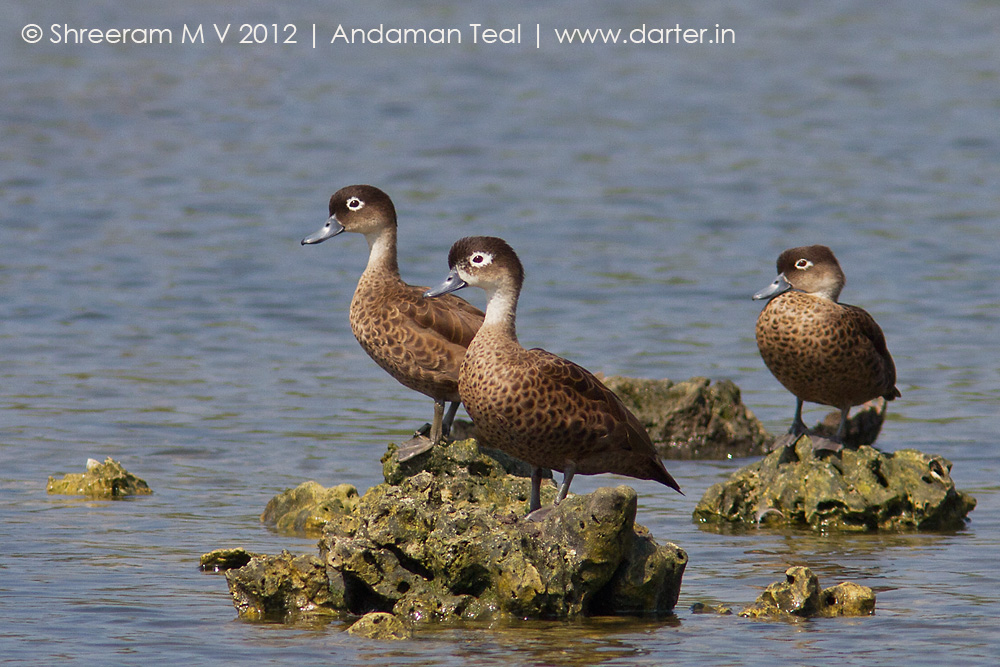In the previous post of this series, we’d discussed about island endemism and listed the species of birds that are considered to be endemic to the Andaman Islands. Starting with this post, over the next few weeks, we’ll look at some of these endemic species and understand more about them.
On my first visit to Andamans in February 2012, the Andaman Teal was high on my list. It is the only endemic species of duck to the islands. Every wetland that we passed by was keenly searched for this rare bird. It was finally near Ogranbrange that we got our first views of the bird.
As we started looking around, more and more came into view. Till we counted more than 100 birds! They were scattered across 2 ponds that were separated by an embankment. Some of them were on rocks in the water. Some of them were foraging in the shallow waters. What was striking was none of the ducks seemed to have the same amount of white on their face.
On our next tour in December 2012, we came across a small group of 5 ducks floating around at the same place. In February 2013, we saw a group of around 30 ducks at a water body near Sippyghat. In addition to the Andaman Teals, we also came across a huge flock of Lesser Whistling Ducks at this location. Lesser Whistling Ducks are the only other resident species of ducks in the Andamans. There was also a lone Eurasian Widgeon amongst the flock, probably a vagrant.
According to our guide Vikram Shil, these birds were seldom seen before the tsunami. With their old swamps destroyed and newer ones created during the tsunami, they have moved into new locations. What was surprising was that both the places that we came across the birds were close to the road and there was human presence (houses, workshops, abandoned construction) around the place.
Description and Ecology
Andaman Teal (Anas albogularis) is a species of duck that is endemic to the Andaman Islands. It is sometimes considered to be a subspecies of the Sunda Teal (Anas gibberifrons). These are small ducks that are found in inland water bodies, as well as mangroves and lagoons. The bird is dark brown in colour, with buff scaly patterns on the underside. The head is dark brown with variable white marking around the eye (some of the older birds have an almost completely white head).
They have been observed in groups larger than 100 individuals. They are known to move locally between water bodies.Sometimes, they also formed mixed species groups with Lesser Whistling Duck (Dendrocygna javanica). Molluscs and arthropods are a majority of the Teal’s diet, in addition to plant matter. They feed in shallow waters with sparse vegetation during the non-breeding season but prefer reeds with thick cover during the breeding season.
They have very few predators. Water Monitors (Varanus salvator) have been known to feed on their eggs. Raptors and large snakes may also predate on them.
Conservation The Andaman Teal is considered to be a globally threatened species, with the population estimated at around 500-600 individuals (according to a study in 2003-04 by Lalitha Vijayan, et al) and declining. Historically, the decline in population was attributed to human pressures including:
- Habitat loss due to reclamation of wetlands
- Hunting
- Poaching for eggs
However, due to the tsunami on Dec 26, 2004, many of the swamps and creeks in the islands were lost either by sand filling up or by getting filled with sea water. This is also believed to have impacted Andaman Teal numbers. A detailed and long-term study would help in getting a better understanding of this endangered species.
Darter Photography conducts wildlife photography tours to Andamans during winters. Please visit our Emerald Isles page for more details on upcoming tours.
References:
- Andaman Teal. Wikipedia
- Lalitha Vijayan, V.Murugan, M.A.Raja Mamannan. 2006. Conservation of Andaman Teal. The Bulletin of the Threatened Waterfowl Specialists Group No.15
- M.A.Raja Mamannan, Lalitha Vijayan. Impact of coastal habitat changes on population of the Andaman Teal



